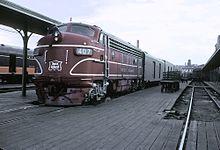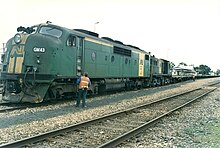Commonwealth Railways GM-Class
| Commonwealth Railways GM-Class | |
|---|---|
|
GM 29 in Rawlinna , 1986
|
|
| Numbering: | GM 1 - GM 47 |
| Number: | 47 |
| Manufacturer: | Clyde Engineering |
| Year of construction (s): | 1951-1967 |
| Axis formula : | (A1A) '(A1A)' and Co'Co ' |
| Gauge : | 1435 mm ( standard gauge ) |
| Service mass: | 114 t |
| Hourly output : | 1118 kW and 1305 kW |
The GM-Class of the Australian state railroad company Commonwealth Railways (CR) is a series of six-axle diesel-electric locomotives from Clyde Engineering in Granville , New South Wales . Due to the different engines, the series is also divided into GM1 (first eleven machines) and GM12 (following locomotives). All locomotives built for the CR were initially regular- gauge , some of which were later switched to the 1600 mm gauge (Irish broad gauge).
History and description

Based on the US-American series EMD FP7 , a four-axle diesel locomotive from General Motors Electro-Motive Division (EMD), Clyde Engineering developed a six-axle variant for use in Australia. This was necessary because the axle load could only be limited to around 18 t with two three-axle bogies . In addition, the smaller Australian clearance profile required a slightly lower and narrower car body . This made the machine longer than the FP 7, which is also better sealed against the ingress of dust.
The external shape of the GM class is almost identical to the A units of the EMD FP7. The typical head shape ("bulldog nose") of the American archetype was also retained.
The machines only have a driver's cab at one end of the vehicle . Therefore, unless they are coupled “back to back” in pairs, they must be turned on turntables . B-units without a driver's cab as in the FP7 were not built.
In the first eleven locomotives (GM1), the drive of the respective middle axle of the two three-axle bogies was dispensed with, the axle order from GM 1 to GM 11 is therefore (A1A) '(A1A)'. All axes are driven on all of the following machines, they have the Co'Co 'wheel arrangement. Some of the machines were later switched to the gauge 1600 mm (Irish broad gauge).

Water-cooled, slow-running 16-cylinder two-stroke diesel engines of the type EMD 567 ran in the GM . The EMD 567B of the first eleven engines had an output of 1119 kW, the EMD 567C built in from locomotive 12 had an output of 1305 kW.
GM-Class locomotives for other railway companies
Six GM12 locomotives were given to the New South Wales Government Railways (NSWR) in 1955/56 , which they classified as Class 42 in their vehicle fleet. They had the road numbers 4201 to 4206.
Victorian Railways (ViCRail) received 18 locomotives of identical construction to the GM12, from which the first ten machines delivered in 1957/58 differed in their gauge of 1600 mm. Eight more standard gauge locomotives were delivered in 1960/61 for their new north-east line. Victorian Railways referred to these machines as Class S.
Closely related to the GM1 are the 26 Class B 60 locomotives built by Victorian Railways in 1952/53 . They have driver's cabs on both sides and are therefore longer.
Class B 60 museum locomotive B 74 in Benalla , behind it a Class S, 2007
Remarks
- ↑ A-Unit: leading power car with an end driver's cab and streamlined nose; B-Unit: “Booster” without a driver's cab, which is controlled from an A-Unit
Web links
- Standard Gauge GM at comrails.com
Individual evidence
- ^ The direct ancestors: Australian Class B 60 in: NOHABs (Eisenbahn Journal special edition 4/2003), p. 15 ff.
- ↑ GM Class (GM1 to GM12) at railpage.com.au, accessed on October 1, 2018






